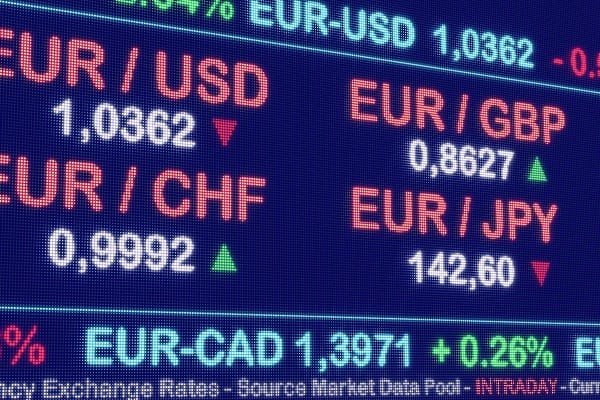Today witnessed wide fluctuations in the performance of the US dollar against a basket of major currencies, following the Consumer Price Index (CPI) figures for August.
With today’s inflation announcement, the euro fell against the US dollar by 0.41% at the peak of declines, reaching the level of 1.07110, while the euro was able to recover some of its gains by returning to the level of 1.07617 at approximately 12:50 pm.
We also saw the Dollar Index rise to the highest level since September 8 at 104.966 with the release of the data, but it reversed to reach the level of 104.558 after 20 minutes of its the previous gains.
In bond markets, we have seen US Treasury yields rise significantly in response to inflation numbers. The yield on two-year Treasury bonds rose to the highest level since August 28 of last year, at 5.079%.
We also saw ten-year Treasury bond yields rise to the level of 4.360%, which is the highest since last August 22. While previous bond yields resumed their losses later, reaching levels of 4.988% and 4.280%, respectively.
While the gains in the US dollar and bond yields came after the August CPI data, which strengthened expectations about the possibility of inflation and interest rates remaining high for a longer period than expected.
Headline annual inflation recorded a higher growth than expected, with a reading of 3.7%, the highest reading since last May, compared to expectations of 3.6%. Monthly inflation also recorded the highest levels since June of last year, at 0.6%, in line with analysts’ expectations.
As for the core inflation (core CPI), we saw a decline in the annual reading to the level of 4.3%, in line with expectations and down from the previous reading of 4.7%, but the monthly reading exceeded expectations, with a reading of 0.3% compared to expectations of 0.2%.
It appears that the August inflation data will not affect the markets’ expectations about the Federal Reserve’s next move at its next meeting by keeping interest rates at their current ranges.
However, the fact that inflation remained high in conjunction with more data that indicated continued improvement in the US economy, whether at the level of the manufacturing or services sector, has already begun to raise expectations, which may seem a little unlikely at the present time, about the possibility of seeing another rise in the price of interest rate by the Federal Reserve at its next meetings this year.
Although it is too early to judge the future path of interest rates, expectations indicate a 40% probability that the central bank will raise interest rates by 25 basis points during its meeting last November, according to the CME’s FedWatch Tool.
Also remarkably today, and speaking to the British market, the British pound deepened its losses today to the lowest levels since last June 8, reaching the level of 1.24346 against the US dollar at the peak of today’s declines, while those losses were followed by some recovery with the restoration of the level of 1.24999.
The price of the Euro against the British Pound also rose to its highest levels in about a month, reaching the level of 0.86306 at the peak of the rises at approximately six-thirty in the morning. However, these rises were followed by a wave of correction that led the euro against the pound to the level of 0.86003 at approximately 9:00 am.
The British pound’s declines today against the major currencies came after more negative data was revealed about the British economy.
We witnessed a higher-than-expected contraction in the GDP for July, at 0.5% on a monthly basis, compared to an expected contraction of 0.2%. This may be the British economy’s highest contraction since last December.
We also saw a noticeable decline, higher than expected, in industrial production, by 0.7% on a monthly basis last July, which is the highest rate of contraction since September of last year. This coincides with a noticeable decline in industrial production in the Eurozone, which was larger than expected, by 1.1%, during last July.
On the other hand, we witnessed a smaller than expected contraction in manufacturing production at 0.8% and the trade balance deficit during last July at 14.06 billion.
These data for the British economy are added to a previous series of negative data, such as the rise in unemployment rates to 4.3% in July and the continued decline in services and manufacturing activities, with readings below expectations for PMI figures for both sectors.
Added to this is a sharp decline in house prices that has not been seen since 2009, coinciding with record high mortgage rates, according to recent data provided by Halifax, which provided more warning signs about the health of the real estate sector.
This data comes a week before the Bank of England announces its decision on the interest rate. While we are witnessing a division in expectations regarding the next step of the Monetary Policy Committee, in light of the mixed economic data.
Despite the noticeable decline in economic activity, we still see expectations that the Bank of England will continue to raise interest rates as inflationary pressures and wage growth continue, while the next hike may be the last from the central bank, despite the talk we have witnessed recently from the Governor of the BoE, which strengthened expectations about the possibility of raising rates twice. On the other hand, the other possibility is for the bank to stop raising interest rates to counter the ongoing economic contraction.
In light of this data, we have seen further declines in British bond yields, which appear to be pricing in the BoE’s approach to actually is about to end interest rates hiking cycle. Two-year British government gilt yields fell to the lowest level on the 25th of last August, at 4.991%, at approximately 12:15 pm.
While the decline in ten-year gilt yields was not less severe, as they fell to the lowest level since the first of this month at 4.394% at approximately 8:30 am. Meanwhile, the decline in bond yields comes amid a recovery in the government bond market, which rose to its highest levels this week, with the iShares Core UK Gilts UCITS ETF reaching the level of 10.0075 pounds at the peak of today’s highs.






Leave a Comment